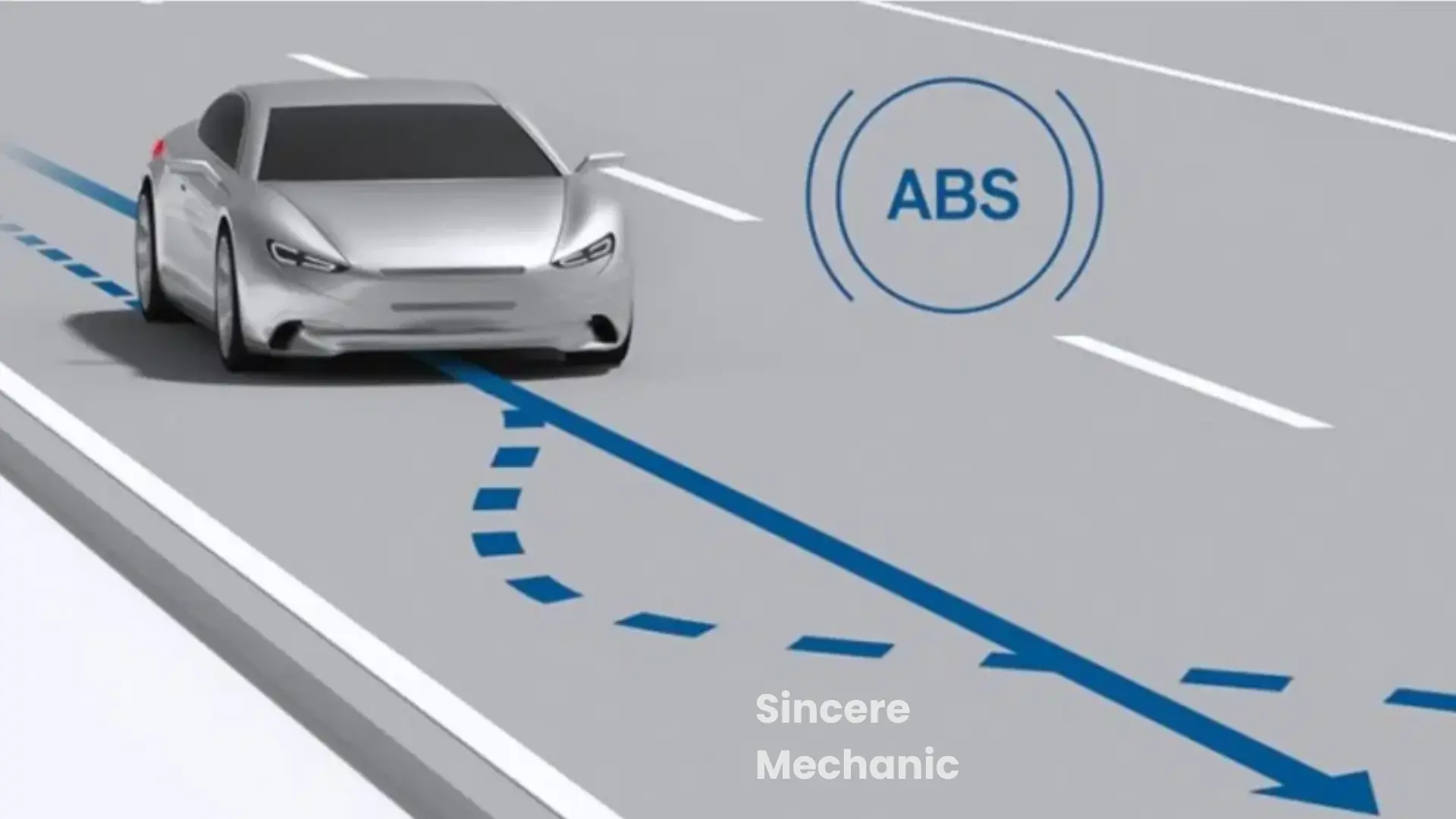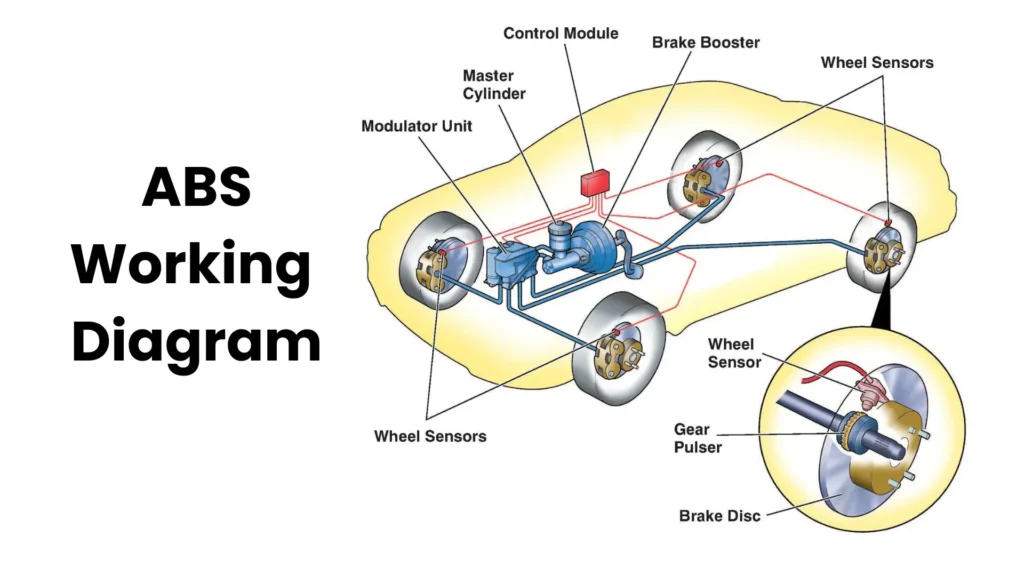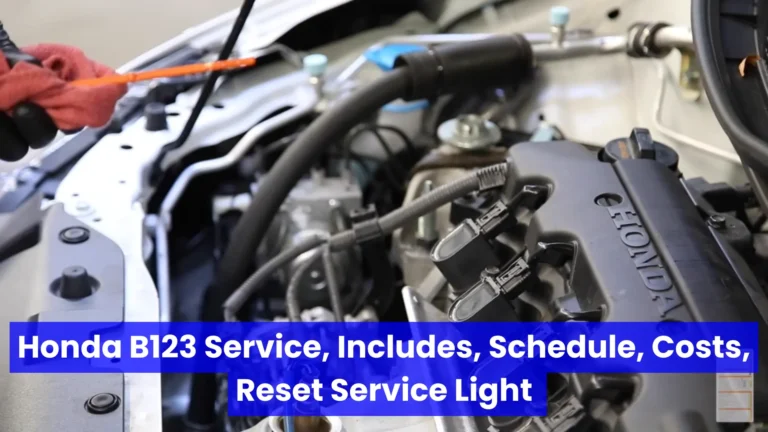Anti-Lock Braking System – How Does ABS System Work?

Safety systems play vital roles in ensuring safety on the road. They use different procedures to perform their tasks. Today, we’ll explore one of these crucial safety features, known as an anti-lock Braking system (ABS), in short form.
Here, you learn how the ABS works and how to fix the ABS light on the car. I’ll cover each of the small steps that you need to have an idea for better driving. Let’s get started!
What is Anti-lock Braking System In A Car?
An anti-lock braking system, also known as ABS, is a highly effective safety feature that helps the wheels prevent locking up to avoid skids on roads. This protection function has also become a common feature in all new modern cars, trucks, and other vehicles.
ABS Working Principle & Mechanism
The working principle and mechanism of the Anti-lock braking system are quite simple and easy to understand. It works by releasing and applying the brakes to the wheels of cars, trucks, and motorcycles in heavy or hard braking situations.
The sensors on each wheel detect locking. In locking conditions, the wheels of your vehicle stop rotating and cause the vehicle to slide or skid. So essentially, here are three stages that ABS uses to work:
- Brake pedal is pushed
- Wheel sensors detect lock up or ‘skidding’
- ABS releases and pumps the brakes
Quick Guide Video:
How Does ABS Work In A Car?
Drivers were taught to pump the brakes when they felt their car steering into a skid. ABS helps to suddenly stop automatically when skidding or in other difficult circumstances.
ABS technology improves the pumping process by focusing on steering the vehicle to safety in emergencies. Anti-lock brakes ensure that the driver can steer in a hard braking event.
The ABS monitors your vehicle’s wheel speed. If a wheel lock is detected, a sensor sends a command to a controller, which applies the brake up to 20 times a second to prevent the lockup and help the driver maintain control.
Now, most cars and trucks have ABS as a crucial safety feature. The ABS operates with other safety systems, such as electronic stability control and traction control, to provide a safe driving experience and protect the vehicle.
Therefore, ABS brakes are standard in all modern cars, whether you have a Toyota, Honda, or Mercedes. It became a legal concern in all new vehicles in the United States on September 1, 2012.
How Does ABS Work In Bikes?
The ABS uses speed sensors to determine wheel speed and sensors to detect locking precisely. It modifies the braking pressure as needed to maintain the motorcycle’s stability and prevent its wheels from locking.
Bikes that have ABS technology are less involved in crashes or potential accidents that occur due to skidding. However, if you also have a bike and are interested in understanding What are motorcycle ABS and how it works, you can read from there:
Motorcycle ABS and how it works
ABS Components
ABS uses various components to perform its procedures. Here are some of these:
Advantages And Disadvantages Of ABS
The pros and cons of a system help people make sensible decisions. Like others, ABS has different favorable and unfavorable factors for its clients. Here, we discuss some advantages and disadvantages of ABS that enhance your understanding of its function.
Advantages of anti-lock braking system
- The ABS decreases the braking distance as suitable pressure is applied to stop the vehicle.
- It prevents uneven tire wear because the wheels don’t lock up when the vehicle stops.
- ABS shares an infrastructure with TCS that helps it easily install TCS (traction control systems) on vehicles in manufacturing.
- ABS reduces the wearing of the brake discs and pads.
- Your vehicle can steer around the obstacles During heavy braking.
- Increases the vehicle’s stopping power, especially when driving on ice roads.
- ABS is an additional good factor that can enhance the resale value of your vehicle. In comparison, A car without ABS will sell at a lower price.
- Cars with ABS technology can keep auto insurance payments down, and the anti-lock brakes are proven to reduce the risk of crashes.
Disadvantages of anti-lock braking system
- Anti-lock brakes improve road safety, but it’s a bit challenging when driving in snowy or gravel areas.
- ABS has variable braking distances because of different surface types.
- It is more expensive to maintain than others.
Anti-lock braking system diagram
The ABS diagram defines the system’s inner workings. When you build a car/light truck mode, you can select to include AB braking by using the assembly wizard. The MotionView anti-lock brake system accumulates information like the pressure of the front and rear master cylinder, wheel speed and longitudinal acceleration of the vehicle, and the brake pedal switch from the MotionView model.
Here is the diagram that help you to understand the working mechanism of Anti-lock braking:

How to fix the anti-lock braking system?
The ABS uses an advanced braking system to help vehicle owners maintain control on slippery or wet roads. When the ABS is on, the warning light informs you that your vehicle might have an issue that needs to be diagnosed and fixed.
For ABS lights on, here are three common reasons that can be:
- Low Brake Fluid
- Faulty Speed Sensor
- Bulb Check
Low Brake Fluid
The brake fluids work directly to control the pressure of braking in ABS. A brake fluid reservoir houses the ABS fluid, which helps reduce the fluid levels in the case of a leak, thus causing the ABS warning to appear on the dash.
Faulty Speed Sensor
Speed sensors perform essential tasks inside each wheel’s hub, like calculating the wheel movement rate. If the wheels of your vehicle are moving slowly or the car faces any problem with the speed sensors, the ABS light appears automatically.
Bulb Check
A checkup of the bulb can also be performed to determine whether the vehicle’s lights are working precisely or not. The ABS lights turn on to indicate if the bulb detects any glitches.
ABS Brakes Problems
Multiple problems can occur with ABS brakes. These are some ways that you can follow to fix them properly:
- If you see the ABS light on your car’s instrument panel, put the key in the ignition and turn your car on and off. This will help resolve minor issues, but if the lights still illuminate even after applying this method, visit your nearby mechanic shop.
- Ensure the front wheel sensors are cleaned if your vehicle’s ABS pulses at a low speed when some pressure is applied. The mechanic will clean the wheel sensors in detail to ensure proper functioning.
- If the ABS brake doesn’t stop, apply pressure. Inspect the master cylinder. If it is low, then fill it to the mentioned level. This practice will ensure that the inside air of your car is in the hydraulic system.
In addition to these ABS brake problems, if you experience any other problem, like a clunking noise when pressing the brakes, seek help from an experienced dealership.
Conclusion
An ABS prevents wheels from locking up and plays a significant role in vehicle safety systems. It protects passengers from fatal crashes or skidding during heavy braking at high speed. ABS has become a mandatory feature in all new vehicles. Therefore, illuminating the ABS lights on the dashboard is a dime a dozen; try to fix it as soon as the lights come on.
Frequently Asked Questions By Drivers
What else is the ABS called?
ABS is mainly known as an “Anti-lock braking system,” “Anti-lock brakes,” or “ABS.”
In what conditions ABS doesn’t work?
The ABS can be unproductive in icy conditions, gravel surfaces, or wet surfaces. There isn’t enough friction in these conditions for the wheels to regain traction when the ABS releases the brakes to let the wheels keep rotating.
How effective is ABS in preventing accidents?
During heavy braking, ABS prevents vehicles from skidding, which would happen if the ABS is not there. The ABS reduces the fatal accidents by:
- 6% in passenger cars
- 8% in LTVs (light trucks, Vans, and SUVs)
What are the benefits of the ABS?
We’ve discussed the ABS advantages and disadvantages in detail, but here are some of the other benefits of that feature that would be helpful:
- It assists the traction control system.
- ABS reduces the braking distance.
- Decreases the wearing of the brake pads as well as brake discs.
- It has a longer lifespan.
How do I know my car has ABS brakes?
You can check the ABS light on startup in the gauge cluster. While the system is checked, the ABS light will come on for seconds and then off. If the ABS light is not on the gauge cluster, consult your car owner’s manual.
When was the ABS invented?
1971
The first anti-lock braking system for Concorde aircraft was developed in the 1960s. The modern ABS was invented by Mario Palazzetti in 1971. Because it was Mario’s invention, he is also known as ‘Mister ABS.’
Martin Lee is an ASE-certified mechanic and contributing author at SincereMechanic. He uses his expertise to create captivating articles that align with our content strategy. Using his deep automobile knowledge, he does in-depth research, puts expertise into articles, and makes them very informative. That information ensures our readers receive many valuable insights about the Vehicles.


![Mercedes A9 Service [Maintenance Cost, Checklist, & Code] 3 Mercedes A9 Service](https://sinceremechanic.com/wp-content/uploads/2024/05/Mercedes-A9-Service-768x432.webp)
![Mazda SCBS Inspection Required [Causes And How To Reset] 4 scbs inspection required](https://sinceremechanic.com/wp-content/uploads/2024/06/scbs-inspection-required--768x432.webp)
![Braking System Fault In Renault [Causes, Fixes & Solution] 5 braking system fault](https://sinceremechanic.com/wp-content/uploads/2024/05/braking-system-fault-768x432.webp)